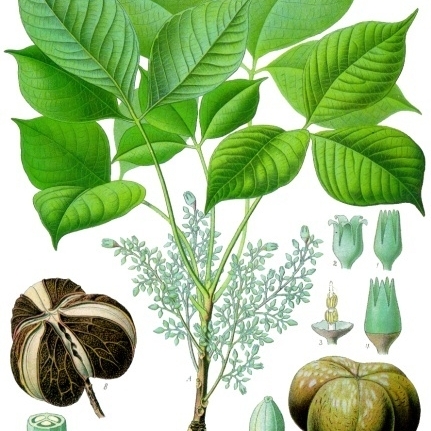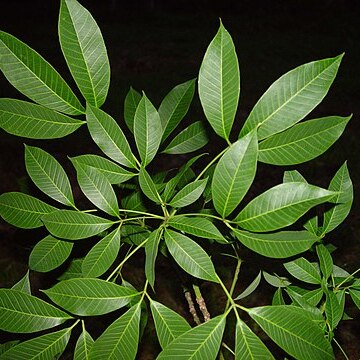Trees, evergreen, perennial, monoecious; stems and foliage with white latex. Indumentum of simple trichomes, glandular trichomes absent, stinging trichomes absent. Stipules entire, inconspicuous, deciduous. Leaves alternate, petiolate, trifoliolate, entire, penninerved; glands 2 at petiole apex. Inflorescences axillary, paniculate, solitary, bisexual and androgynous, with flowers in bracteate clusters. Male flowers pedicellate; calyx lobes 5, valvate, partially connate; petals absent; disc of 5 free or united glands; stamens 5–10, filaments connate into a column; anthers sessile and disposed around the column in 1 or 2 series, dorsifixed, bilobate, thecae oblong and longitudinally dehiscent; pistillodes present. Female flowers pedicellate; calyx lobes 5, valvate, partially connate; petals absent; disc minute or absent; ovary 3-or 4-locular, ovules uniloculate; styles 3 or 4, free, simple or rarely bifid. Fruit capsular, tri-or quadrilobate, surface smooth, dehiscing septicidally into 3 bivalved cocci. Seeds oblong to ovoid; testa crustaceous; albumen reduced or lacking; ecarunculate; cotyledons broad, flat.
Male flowers: calyx ovoid or globose in bud, 5-lobed, the lobes valvate; petals absent; disk glands 5, free or united; stamens 5–10, the filaments united into a column, anthers sessile in 1–2 series, those of the outer series alternisepalous; pistillode at the apex of the staminal column, entire.
Female flowers: calyx as in the male; petals absent; disk minute or absent; ovary ovoid, 3(4)-locular, with 1 ovule per locule; styles short, stigmas thick, spreading, entire or slightly 2-lobed.
Inflorescences axillary, subtended by leaves or bracts, paniculate, androgynous, the central flower of each cymule female, the rest male, protogynous; bracts small, entire.
Leaves alternate, stipulate, long-petiolate, trifoliolate; petiole with an apical gland; leaflets petiolulate, entire, penninerved; stipules small, fugacious.
Seeds large, oblong-ovoid, smooth, blotched, ecarunculate; testa crustaceous; endosperm scanty or absent; cotyledons thick, fleshy, ± equal in size.
Fruits large, trigonous, septicidally dehiscent into 3 bivalved cocci; endocarp woody.
Monoecious laticiferous trees.


